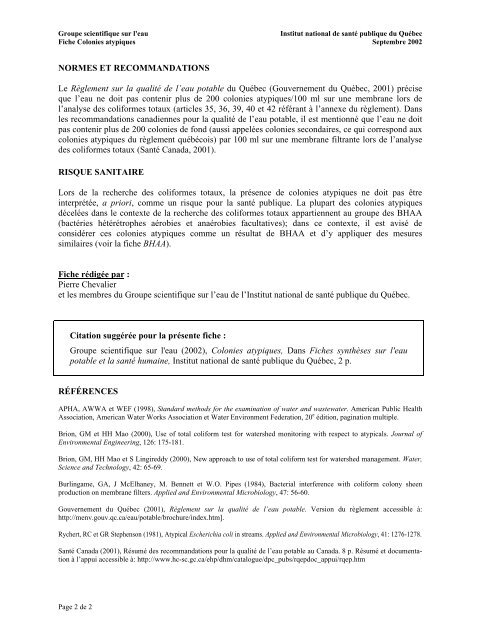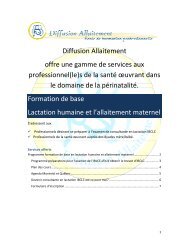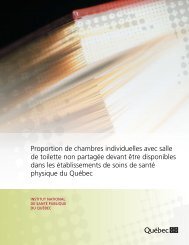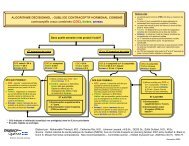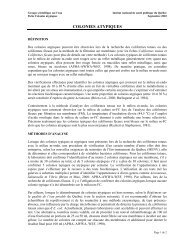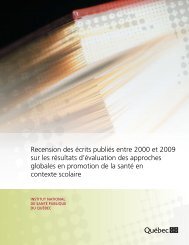Fiches synthèses sur l'eau potable et la santé humaine
Fiches synthèses sur l'eau potable et la santé humaine
Fiches synthèses sur l'eau potable et la santé humaine
You also want an ePaper? Increase the reach of your titles
YUMPU automatically turns print PDFs into web optimized ePapers that Google loves.
Groupe scientifique <strong>sur</strong> <strong>l'eau</strong> Institut national de <strong>santé</strong> publique du Québec<br />
Fiche Colonies atypiques Septembre 2002<br />
NORMES ET RECOMMANDATIONS<br />
Le Règlement <strong>sur</strong> <strong>la</strong> qualité de l’eau <strong>potable</strong> du Québec (Gouvernement du Québec, 2001) précise<br />
que l’eau ne doit pas contenir plus de 200 colonies atypiques/100 ml <strong>sur</strong> une membrane lors de<br />
l’analyse des coliformes totaux (articles 35, 36, 39, 40 <strong>et</strong> 42 référant à l’annexe du règlement). Dans<br />
les recommandations canadiennes pour <strong>la</strong> qualité de l’eau <strong>potable</strong>, il est mentionné que l’eau ne doit<br />
pas contenir plus de 200 colonies de fond (aussi appelées colonies secondaires, ce qui correspond aux<br />
colonies atypiques du règlement québécois) par 100 ml <strong>sur</strong> une membrane filtrante lors de l’analyse<br />
des coliformes totaux (Santé Canada, 2001).<br />
RISQUE SANITAIRE<br />
Lors de <strong>la</strong> recherche des coliformes totaux, <strong>la</strong> présence de colonies atypiques ne doit pas être<br />
interprétée, a priori, comme un risque pour <strong>la</strong> <strong>santé</strong> publique. La plupart des colonies atypiques<br />
décelées dans le contexte de <strong>la</strong> recherche des coliformes totaux appartiennent au groupe des BHAA<br />
(bactéries hétérétrophes aérobies <strong>et</strong> anaérobies facultatives); dans ce contexte, il est avisé de<br />
considérer ces colonies atypiques comme un résultat de BHAA <strong>et</strong> d’y appliquer des me<strong>sur</strong>es<br />
simi<strong>la</strong>ires (voir <strong>la</strong> fiche BHAA).<br />
Fiche rédigée par :<br />
Pierre Chevalier<br />
<strong>et</strong> les membres du Groupe scientifique <strong>sur</strong> l’eau de l’Institut national de <strong>santé</strong> publique du Québec.<br />
Citation suggérée pour <strong>la</strong> présente fiche :<br />
Groupe scientifique <strong>sur</strong> <strong>l'eau</strong> (2002), Colonies atypiques, Dans <strong>Fiches</strong> <strong>synthèses</strong> <strong>sur</strong> <strong>l'eau</strong><br />
<strong>potable</strong> <strong>et</strong> <strong>la</strong> <strong>santé</strong> <strong>humaine</strong>, Institut national de <strong>santé</strong> publique du Québec, 2 p.<br />
RÉFÉRENCES<br />
APHA, AWWA <strong>et</strong> WEF (1998), Standard m<strong>et</strong>hods for the examination of water and wastewater. American Public Health<br />
Association, American Water Works Association <strong>et</strong> Water Environment Federation, 20 e édition, pagination multiple.<br />
Brion, GM <strong>et</strong> HH Mao (2000), Use of total coliform test for watershed monitoring with respect to atypicals. Journal of<br />
Environmental Engineering, 126: 175-181.<br />
Brion, GM, HH Mao <strong>et</strong> S Lingireddy (2000), New approach to use of total coliform test for watershed management. Water,<br />
Science and Technology, 42: 65-69.<br />
Burlingame, GA, J McElhaney, M. Benn<strong>et</strong>t <strong>et</strong> W.O. Pipes (1984), Bacterial interference with coliform colony sheen<br />
production on membrane filters. Applied and Environmental Microbiology, 47: 56-60.<br />
Gouvernement du Québec (2001), Règlement <strong>sur</strong> <strong>la</strong> qualité de l’eau <strong>potable</strong>. Version du règlement accessible à:<br />
http://menv.gouv.qc.ca/eau/<strong>potable</strong>/brochure/index.htm].<br />
Rychert, RC <strong>et</strong> GR Stephenson (1981), Atypical Escherichia coli in streams. Applied and Environmental Microbiology, 41: 1276-1278.<br />
Santé Canada (2001), Résumé des recommandations pour <strong>la</strong> qualité de l’eau <strong>potable</strong> au Canada. 8 p. Résumé <strong>et</strong> documentation<br />
à l’appui accessible à: http://www.hc-sc.gc.ca/ehp/dhm/catalogue/dpc_pubs/rqepdoc_appui/rqep.htm<br />
Page 2 de 2


